Heteronymphas, Ogyris and Far North Queensland
To Blackheath for Heteronymphas
In March I twice went to Blackheath in the Blue Mountains, hoping to get better photos of some Heteronymphas. I’ve previously had some luck at the Campbell Rhododendron Gardens and this was where I spent much of my time on these two days.
The first occasion was on 1st March and there were 4 Heteronympha species on the wing, predominantly H. paradelpha (Spotted Brown), though the weather was not at all helpful. Blackheath seems to be a rather contrary place as far as the weather is concerned. When I go there in November/December for interesting skippers and Hypochrysops delicia I want the weather to be hot and sunny, but more often than not it’s largely overcast with some sunny breaks. For Heteronymphas it’s better if the day is not too hot and is partly overcast, so of course on this particular day it ended up being 30C without a cloud in the sky. As a result the butterflies were mostly staying in the darkest shady spots and I had few chances to get decent shots.
Three weeks later I was back and the weather was more suitable, though this time a bit more sunshine would have been helpful. H. paradelpha had largely finished by now, and most of the butterflies were female H. banksii (Banks’ Browns). I was able to get some fairly decent open-wing shots of them, but not quite as good as I would have liked, so I think I’ll be back there again in February/March next year.

01/03/2025

22/03/2025
Ogyris at Mount Annan
In mid-April I went out to the Mount Annan Botanic Garden; my target was Ogyris amaryllis (Satin Azure), a butterfly I’ve seen a number of times but without much luck in getting photos. I got there early in the morning in the hope of finding them before they warmed up and became frisky. That didn’t work out as I didn’t see any for about an hour, after which I got the occasional glimpse of an amaryllis zipping extremely rapidly about the tops of the Casuarina trees.
It was mostly sunny, but one of the few clouds drifted across in front of the sun and to my delight a male amaryllis settled on a branch a few metres above my head. As usual I had my Sigma 150mm macro lens on the camera so I took a few shots of him. He showed no signs of taking off so I quickly switched to my 300mm prime lens and took a load more photos, some also using a 2x extender. I was fortunate enough to observe him as the sunshine came and went, with the camouflage markings of his underside changing in colour according to the light conditions.
Over a period of a few hours I was able to get photos of males and females. Inevitably, when I had the long lens on the camera an amaryllis would come low down and settle a few inches from my face – it seems to be a law of nature that whatever lens you have on the camera the butterflies will make you wish you had the other lens. Despite this I had a rather successful day and was able to significantly improve the amaryllis page on this website.


Cooktown and Cairns : April 2025
During February I noticed that Easter was going to be late this year, with Easter Monday and ANZAC Day falling in the same week, meaning I was able to get a decent break from work without taking too many of my annual leave days. I told my Cairns butterflying mate Ross that I was thinking of going up to north Queensland. We discussed maybe going to Iron Range but settled on a few days in Cooktown, a place I’d only visited for part of one day back in March 2016, followed by some time in Cairns. Our friend Derek, a butterfly photographer from Perth, also signed up for this trip.
17th April
And so on the Thursday before Easter I was up stupidly early to catch the 06:10am flight from Sydney to Cairns. Ross met me at the airport, then we picked up Derek (who’d flown in from Perth the evening before) and headed up to Cooktown. Unlike most of my visits to Cairns, it did not begin raining within 30 minutes of my plane landing, in fact it was a beautiful sunny day all day long.
We’d decided to spend that first afternoon at a spot Ross knows where we might be able to see Royal Jewels (Hypochrysops polycletus) and Peacock Awls (Allora doleschalli). These would be new species for Derek and I, and in my case they were the top two targets for the whole trip. This site is on private property owned by an acquaintance of Ross’ who fortunately didn’t mind us photographing his butterflies whilst in Ross’ company. There were plenty of butterflies around with the number of Orange Planes (Pantoporia consimilis) and Narrow-brand Darters (Telicota paceka mesoptis) being notable, which was to be a consistent feature of this trip both at Cooktown and at Cairns.
While Ross searched for larvae and pupae Derek and I photographed as many butterflies as possible, keeping an eye out all the time for polycletus and doleschalli. Around 5pm we were beginning to feel that it wasn’t going to happen that day, when a doleschalli appeared flying around a Lantana right next to where we were standing. It repeatedly settled to feed from the flowers, though it was only still for a few seconds before zipping around and settling on another flower nearby. It hung around for a couple of minutes and though I had good views of it I was only able to get one photo, partly because of its annoying habit of sitting front-on to me. The photo wasn’t fantastic, but it was definitely good enough to use on the website (and WAY better than the photo I got of its close relative Allora major when I went to Iron Range in November 2013). Derek also managed to get shots of it, so it turned out to be a good ending to the day’s butterflying. As the old saying goes, “awl’s well that ends well”.


18th April
The following day we went out to Laura to look for Erina delospila (Spotted Dusky-blue). This was almost a replay of the day in June 2022 when Ross and I went to the same location to look for delospila, as we saw plenty of Erina erina (Small Dusky-blue) and a few Eurema herla (Macleay’s Grass Yellows), but delospila was conspicuous by its absence. However on this occasion when Ross and I went up to the ridge we actually found some butterflies, beginning with Proeidosa polysema (Spinifex Sand-skipper). This became my second new species for the trip; it had also been amongst my top 5 targets as I’d long wanted to see this butterfly. There were maybe half a dozen of them hilltopping on the ridge, some of which were decent specimens and others which were very tatty. Unfortunately the weather then chose this moment to intervene; it clouded over and the wind strengthened, to the point where it became quite cool by north Queensland standards. It was very exposed on that ridge, and for some reason the polysema seemed to prefer the windward side, so much so that it was difficult to get sharp photos as they were shivering.
Ross and I eventually decided to head back down, but we went by a different (less steep) route. On the way we crossed an open area with a small rock pavement where male Hesperilla crypsigramma (Wide-brand Sedge-skippers) and H. sexguttata (Riverine Sedge-skippers) were defending little territories. I was particularly pleased to see sexguttata as I’d only seen that species once before, at McLeod River in April 2024, and on that occasion I only saw them sitting with their wings closed whereas this time I was able to get an open-wing shot.
On the way down Ross had a tentative sighting of a delospila, and Derek had had another whilst we were on the ridge top, but we had no definite sightings and no photos or specimens were taken. On our way back out to the main road we stopped to investigate a stand of small wattles in the hope of finding Jalmenus eichhorni (Northern Hairstreak), a butterfly I’ve only seen once. Unfortunately the only butterflies flying there were Theclinesthes miskini (Wattle Blues), though there were a number of Jalmenus larvae and pupae.


19th April
Today Ross took us out to visit his friends Lewis and Charlie Roberts; I’ve heard about the brothers and their property near Shipton’s Flat lots of times in the past so this was quite a thrill. This is also meant to be a great place for polycletus, but it was mostly overcast that day and so there weren’t many butterflies to be seen. We spent much of the time around the more open spots along the road, photographing the Mydosama terminus (Orange Bush-browns) and Pantoporia consimilis (Orange Planes) that were sitting with their wings spread flat in order to catch whatever UV was to be had. Lewis and Ross searched around for the very small, young Rhyssopterys vines that polycletus prefers, and before long Ross was showing me a fat polycletus larva.
Later in the morning it brightened up and we got some decent sunshine, which brought out a lot of butterflies. They were mostly common species that can be found easily enough around Cairns, with the highlights for me being Euploea sylvester (Two-brand Crow), and an absolutely beautiful Tagiades japetus (Pied Flat) which was easily the best specimen I’ve seen of that species. I had the feeling that if the sunshine persisted we’d get to see some of the rarer stuff, but unfortunately it soon became completely overcast and almost all the butterflies disappeared.
We gave up and went back to the spot where we’d seen doleschalli on the first afternoon, but before long the rain set in and we didn’t get to see much at all for the rest of the day.


20th April
We only had the morning to look for butterflies, as we were returning to Cairns in the afternoon, so we returned to the doleschalli spot to have one last try for polycletus. The weather was better – partly cloudy but with plenty of sunshine – and the butterflies were plentiful. They were mostly common species, but every now and then something more interesting would show up, the first of these being Doleschallia bisaltide (Leafwing), a butterfly I’ve had little luck with over the last 10 years or so, followed by a pristine male Euploea eichhorni (Eichhorn’s Crow) who sat and posed nicely for photos.
Just before 11am I heard Ross calling me. I was maybe 200 metres from he and Derek, but it sounded like they’d found something good so I set off as fast as I could (which isn’t very fast these days!). Derek had spotted a fantastic male polycletus, just sitting on a Lantana leaf close to a large Rhyssopterys vine. He’d already got some shots so I moved in to get my first photos of a butterfly I’d been hoping to find ever since my first trip to Cairns 20 years earlier. I was using the flash and the polycletus jumped a little with my first shot, just enough to give us a view of the incredible blue colour of his upperside. After that he didn’t move much at all – I wish all butterflies were as cooperative. Unfortunately the Lantana prevented me from getting into a fully side-on position, so I could only photograph the butterfly from a bit of an angle, but this encounter was a huge thrill for me as I picked up my third new species for the trip.
Derek had actually photographed a female polycletus a little earlier; a rather tatty specimen as she was quite high up so it wasn’t possible to get a really good shot. I didn’t see her, but a bit later on another female was seen up in a tree, also tatty and high up. I took one photo of her; it’s terrible but she’s the only female polycletus I’ve seen so I did use the shot on the website.
We were a little reluctant to leave when there were such great butterflies around, but we had to head back to Cairns. I’d got photos of 3 new species in 4 days; it’s been a long time since that happened!

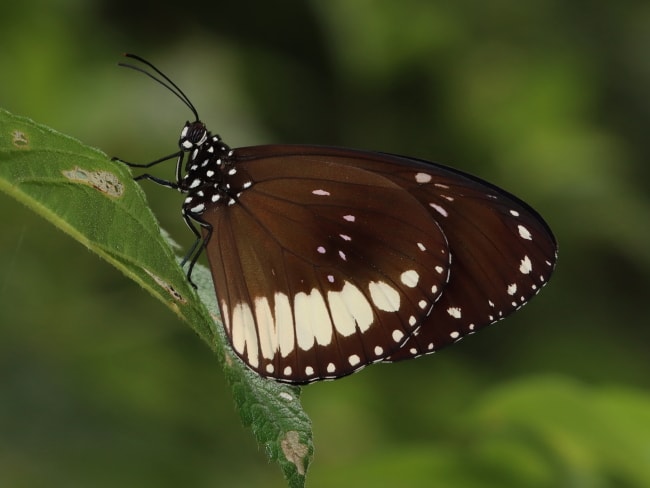
21st April
For the next few days it was just Derek and I as Ross had to work. We decided to start off by looking around the Cairns Botanic Gardens as we’ve both had some success there in the past, though I haven’t found it so productive in the last few years. We only saw one single Orange Bush-brown in the time we spent in the Gardens, which was an incredibly bad showing, and the Cairns Central Swamp wasn’t much better. I don’t think either of us had spent such a poor day around Cairns, so in the late afternoon we went out to the Jack Barnes Mangrove Boardwalk near the airport. There aren’t many butterfly species to be seen there, but it’s a good site for Hypochrysops apelles (Copper Jewel) and H. narcissus (Narcissus Jewel) which are gorgeous butterflies and always worth seeing.
It didn’t take long for us to find a male narcissus sitting on a leaf at a very convenient height right next to the boardwalk; he sat very still until we’d finished taking our photos before he disappeared at great speed.
After that we didn’t have much luck with narcissus; I did get a couple of shots of a female but we mostly just saw them in flight. As the afternoon wore on it increasingly became the apelles show; at times there were half a dozen of them dogfighting together, and they became increasingly likely to settle in places where we could get good shots. The only things more numerous than the apelles were the mosquitoes, which soon discovered that I’d forgotten to bring any repellant along and so feasted eagerly on me.


22nd April
Derek and I headed inland to the Atherton tablelands today, with our first stop being at Rifle Range Road at Atherton. Unfortunately it was a mostly overcast day with just the occasional sunny break, which was to be the norm for the rest of the trip. There were a few interesting species around, such as Arrhenes dschilus (Scrub Darter) – one of my favourite Hesperids – and Tellervo ziolus (Hamadryad), but the weather was clearly keeping butterfly numbers down.
We decided to seek brighter conditions so we moved onto Herberton, where we stopped at a small hill not far from the well-known Specimen Hill. Close to where Derek parked the car were some flowers which had attracted a few butterflies, mainly Prosotas dubiosa (Purple Line-blue) and Taractrocera papyria (White-banded Grass-dart). Derek stayed near the flowers while I went up to see what was up around the top of the little hill. That turned out to be a big mistake on my part as there was nothing interesting up there, but Derek got shots of Trapezites heteromacula (Small Orange Ochre), of which I’ve only ever seen one specimen. By the time I came back down the heteromacula had gone, though there was a Jalmenus pseudictinus (Macqueen’s Hairstreak) feeding from the flowers so I took photos of that as my consolation prize.
Towards the later part of the afternoon we headed off to Wondecla in search of Euschemon rafflesia (Regent Skippers), as neither of us had photos of these butterflies (though I do have shots of larvae and pupae). We didn’t see any sign of them at all, in fact the only interesting thing we found was a female Trapezites symmomus sombra, the north Queensland subspecies of the Splendid Ochre; this was only the second of I’d ever seen.


23rd April
This was another day spent around Cairns itself, and yet again the weather did its best to spoil the day. We started off by going out to the roadside at Lake Placid, where in the past I’ve come across some very decent butterflies including my first Bindahara phocides (Sword-tailed Flash). There were not all that many things flying, and what we saw were all the same common species that we were seeing every day. The most interesting finding was a huge male Hercules Moth (Coscinocera hercules) that Derek spotted; I’m embarassed to admit I had somehow managed to walk right past it several times without seeing it.
After a couple of hours we decided to move onto the nearby Barron Gorge Road; I’d never been butterflying there but from Google Street View it looked like a promising place. It might have been good on a better day, but now the weather closed in with heavy overcast and some rainfall, so we saw very little. The only butterfly I photographed here was a Notocrypta waigensis (Banded Demon), which was not a bad find as I hadn’t got any shots of this species since 2016.
Our final site for the day was Crystal Cascades. The weather did brighten up a bit and we got some sunny intervals, so there were some butterflies to be seen, including several more waigensis. We went to the end of the path, in the hope of seeing polycletus which has been seen occasionally there. There was no sign of it but we did get some shots of a male Symbrenthia geoffroyi (Jezebel Nymph) and we had some great sightings of Papilio ulysses (Ulysses Swallowtails). On the way back to the carpark we finally had some luck with Papilio ambrax (Ambrax Swallowtails). We’d seen a few around but they had never given us a chance, but now they were puddling at wet patches along the path it wasn’t difficult to get some decent shots.
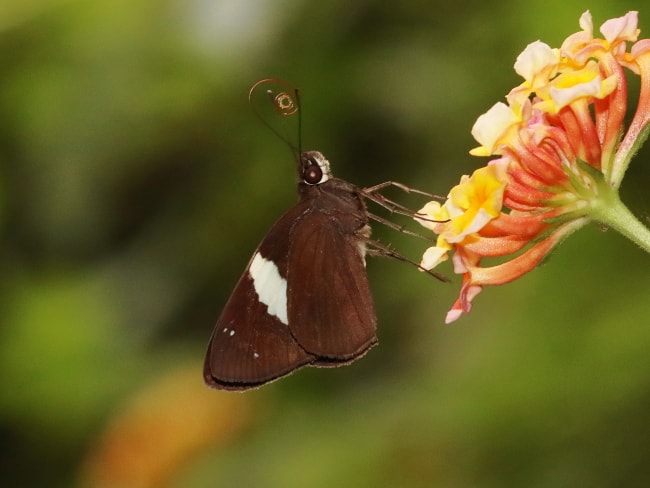
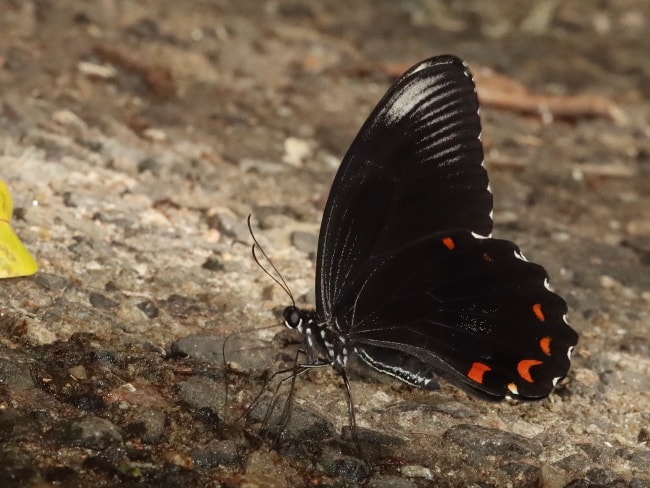
24th April
We had unfinished business in the Tablelands, so we went back out there to see if we might have better luck with the weather. The weather didn’t like that idea at all, so it stubbornly remained locked into the same ‘mainly cloudy’ mode. On the way out to Atherton we took a detour down to Davies Creek just to see what might be there. The answer was “not a lot”, though in the few moments when we had sunshine there were definitely more butterflies around. For me the only notable species was a Parnara bada (Grey Swift); I was able to add one more photo to my very small collection of bada shots.
At Atherton conditions were exactly the same as we’d faced 2 days earlier, though we did have a little more luck. We arrived to find a female Papilio aegeus (Orchard Swallowtail) who seemed quite keen to have have her photo taken, and soon after a brand-new Sabera dobboe (Yellow-streaked Swift) was equally cooperative. Whilst the aegeus was old and rather battered, this dobboe was really fresh and very dark in colour, especially under the poor light conditions.
As the light deteriorated further the butterflies became harder to find, though a female Junonia orithya (Blue Argus) settled rather fetchingly on a lichen-encrusted branch. We were just about ready to give up and move on when Derek somehow managed to see a butterfly hiding in a dark and sheltered spot about 20 feet up in a tree. I have no idea how he managed to spot that, but it turned out to be the Hypochrysops miskini (Coral Jewel), the butterfly we’d really been hoping to find at this location. We took it in turns to use my 300mm lens, seeing as the butterfly was quite high up, though when I viewed my photos on my large monitor I found that the photos I took using my 150mm macro were actually better; surprisingly decent considering how bad the light was and how far up the miskini was sitting.
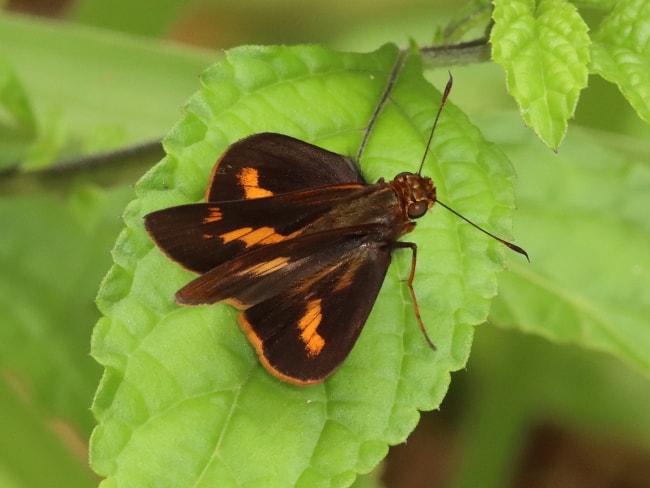
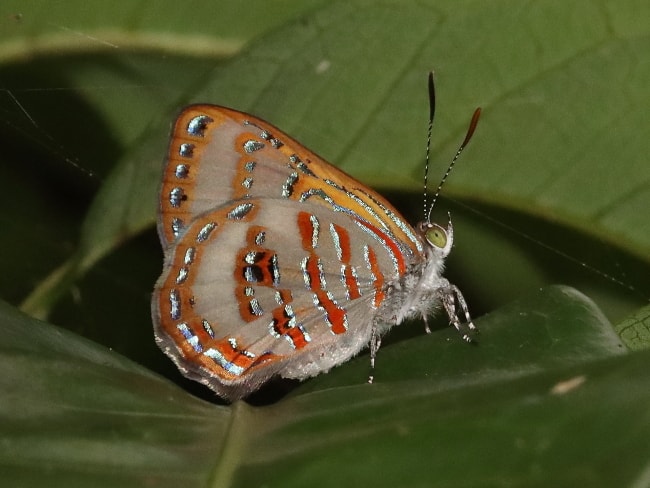
25th April
With today being the ANZAC Day public holiday Ross was able to join us, and we headed back to the Tablelands. I’d previously photographed males of Trapezites maheta (Northern Silver Ochre), but I’d never really managed to get really good shots and I’d never seen a female, so Ross took us to a swampy area near Herberton to look for this butterfly (and hopefully some other interesting species too). It was cool and cloudy at first so we got off to a slow start, but after a while we began to find maheta, both males and females. The males were a mixed bag, some being brand new and other being worn, whilst the females were all rather old and faded. I spotted one Hesperilla sarnia (Swift Sedge-skipper) but it was disturbed by a dragonfly so I wasn’t able to get any shots, and Ross saw a Hesperilla ornata monotherm (Spotted Sedge-skipper) which I wish I could have seen as I’ve only seen this subspecies once and wasn’t able to photograph it.
In the afternoon Ross showed the value of having a big 4WD by driving us up the bumpy old track up Specimen Hill. It was sunny on the way up but – inevitably – it clouded over just as we arrived. Every now and then we got a sunny break, at which the butterflies soon began to appear. We’d just spotted a male Trapezites macqueeni (Bronze Ochre) when another 4WD came up the track and scared it off. During the last week or so Derek and I had noted that when we tried to photograph an interesting butterfly someone would come along and disturb it. It didn’t happen every single time, but it was common enough for us to be getting a bit pissed off about it. Having it happen at the top of Specimen Hill was really taking things a bit too far, especially as T. macqueeni would have been a new species for Derek. The driver turned out to be another Cairns-based butterflyer, so Ross chatted to him while Derek and I tried to reacquire the macqueeni; we probably should have joined in the chat but as this was our penultimate day of butterflying on this trip we were keen to make the most of it. We did eventually find the macqueeni; it’s not the most exciting Trapezites species and he wasn’t the greatest specimen, but I was very happy with one of the shots I took of him.
Finally we checked out the little hill just a short distance down the road from Specimen Hill; the same Jalmenus pseudictinus was still feeding from the flowers but there wasn’t much else around, so we drove back to Cairns.

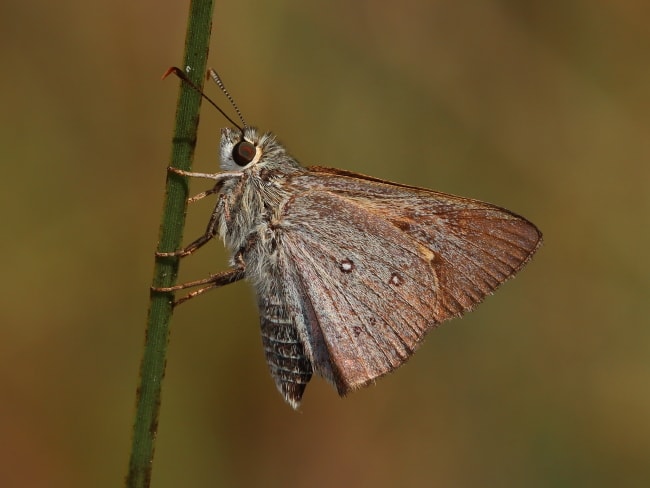
26th April
For our last day Derek and I again went to the Tablelands. The weather was supposed to be improving – naturally enough since we were both returning home the following morning – and we had hopes of seeing more H. miskini at Atherton and more skippers at Herberton. This time we stopped in at the Kuranda hilltop on the way out from Cairns, as we hadn’t yet visited the place at all on this trip. There were several Eurema hecabe (Large Grass-yellows) on the hilltop, and a solitary Zizeeria karsandra (Spotted Grass-blue) made a brief appearance, but after a while the clouds came over and most of the butterflies disappeared other than a surprisingly well-behaved Vindula arsinoe (Cruiser).
At Atherton Derek repeated his trick of spotting an inconspicuous small butterfly high up in a tree; this time it was a female Pseudodipsas cephenes (Bright Forest-blue). Whilst not being the greatest specimen she was still a really good find, being a new species for Derek and only the second cephenes I’d ever photographed.
We didn’t see much else so we went on to the Herberton swamp, but by now it was getting quite late in the afternoon and the temperature was dropping. Very little was flying, though I did get shots of a worn male T. maheta and a very fresh female Telicota ancilla (Green Darter). The latter was the last butterfly I photographed on the trip, as shortly afterwards we gave up and headed back to Cairns.
Despite the mainly overcast weather I’d have to count this as a successful trip. I got photos of 3 new species and Derek managed something like 22 (he’s been to Cairns less often than I have). We’re hoping that the three of us can all go butterflying in Derek’s WA stomping ground in the Spring; fingers crossed…


Photo Gallery Updates
New species : Hypochrysops polycletus (Royal Jewel)
New species : Allora doleschalli (Peacock Awl)
New species : Proeidosa polysema (Spinifex Sand-skipper)
I’ve also added photos to the following species pages:
Graphium macfarlanei (Green Triangle) larva only
Papilio aegeus (Orchard Swallowtail)
Papilio ambrax (Ambrax Swallowtail)
Pachliopta polydorus (Red-bodied Swallowtail)
Catopsilia pomona (Lemon Migrant)
Eurema brigitta (No-brand Grass Yellow)
Eurema herla (Pink Grass Yellow / Macleay’s Grass Yellow)
Eurema hecabe (Large Grass Yellow)
Elodina parthia (Chalk While / Striated Pearl-white)
Cepora perimale (Caper Gull)
Euploea sylvester (Two-brand Crow)
Euploea corinna (Common Crow)
Euploea eichhorni (Eichhorn’s Crow)
Tellervo zoilus (Hamadryad)
Cethosia cydippe (Red Lacewing)
Vindula arsinoe (Cruiser)
Cupha prosope (Bordered Rustic)
Pantoporia consimilis (Orange Plane)
Neptis praslini (Yellow-eyed Plane)
Mynes geoffroyi (Jezebel Nymph / White Nymph)
Junonia orithya (Blue Argus)
Junonia villida (Meadow Argus)
Junonia hedonia (Chocolate Argus)
Yoma sabina (Lurcher)
Hypolimnas alimena (Blue-banded Eggfly)
Doleschallia bisaltide (Leafwing)
Melanitis leda (Evening Brown)
Mycalesis perseus (Dingy Bush-brown)
Mydosama terminus (Orange Bush-brown)
Tisiphone abeona (Swordgrass Brown)
Heteronympha penelope (Shouldered Brown)
Heteronympha paradelpha (Spotted Brown)
Heteronympha banksii (Banks’s Brown)
Pseudodipsas cephenes (Bright Forest-blue)
Hypochrysops narcissus (Narcissus Jewel)
Hypochrysops miskini (Coral Jewel / Miskin’s Jewel)
Hypochrysops apelles (Copper Jewel)
Arhopala madytus (Bright Oak-blue)
Arhopala micale (Shining Oak-blue)
Arhopala wildei (White Oak-blue / Small Oak-blue)
Ogyris amaryllis (Satin Azure)
Jalmenus eichhorni (Northern Hairstreak) larva and pupa only
Jalmenus pseudictinus (Pseudictinus Blue / Macqueen’s Hairstreak)
Hypolycaena phorbas (Black-spotted Flash / Common Tit)
Eirmocides absimilis (Common Pencil-blue)
Erina erina (Small Dusky-blue)
Nacaduba kurava (White-banded Line-blue)
Nacaduba cyanea (Green-banded Line-blue)
Psychonotis caelius (Small Green-banded Blue)
Prosotas dubiosa (Purple Line-blue)
Theclinesthes miskini (Wattle Blue)
Jamides phaseli (Purple Cerulean)
Jamides aleuas (White-banded Cerulean)
Catochrysops panormus (Pale Pea-blue)
Leptotes plinius (Zebra Blue)
Zizeeria karsandra (Spotted Grass-blue)
Famegana alsulus (Black-spotted Grass-blue)
Tagiades japetus (Pied Flat / Black and White Flat)
Trapezites maheta (Northern Silver Ochre / Maheta Skipper)
Trapezites macqueeni (Bronze Ochre / Macqueen’s Skipper)
Trapezites symmomus sombra (Splendid Ochre / Symmomus Skipper); north Queensland subspecies
Dispar compacta (Barred Skipper / Dispar Skipper)
Toxidia crocea (Narrow-brand Grass-skipper)
Toxidia thyrrhus (Dusky Skipper)
Hesperilla sexguttata (Riverine Sedge-skipper)
Hesperilla crypsigramma (Wide-brand Sedge-skipper)
Notocrypta waigensis (Banded Demon)
Parnara bada (Grey Swift)
Pelopidas lyelli (Lyell’s Swift)
Taractrocera papyria (White-banded Grass-dart)
Ocybadistes ardea (Orange Grass-dart)
Arrhenes dschilus (Scrub Darter)
Telicota ancilla (Green Darter)
Telicota augias (Bright-orange Darter)
Telicota paceka (Narrow-brand Darter)
Cephrenes augiades (Orange Palm-dart) dark form
Cephrenes trichopepla (Yellow Palm-dart)
Sabera dobboe (Yellow-streaked Swift)
Contacts page
Whilst working on the November 2023 update I tested out my Contacts page and found that my email form is no longer working. I don’t know why it broke or when it happened, so if you’ve tried contacting me that way and received no reply, please accept my apologies.
I had a go at fixing it but didn’t get it working. In the meantime I’ve replaced the form with links to my Facebook and Instagram, as it should be possible to contact me that way instead.
